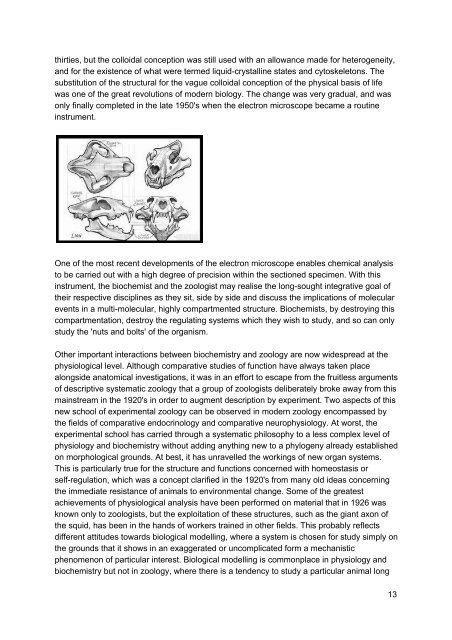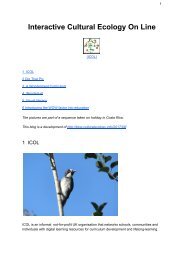scopeofzoology
You also want an ePaper? Increase the reach of your titles
YUMPU automatically turns print PDFs into web optimized ePapers that Google loves.
thirties, but the colloidal conception was still used with an allowance made for heterogeneity,<br />
and for the existence of what were termed liquid-crystalline states and cytoskeletons. The<br />
substitution of the structural for the vague colloidal conception of the physical basis of life<br />
was one of the great revolutions of modern biology. The change was very gradual, and was<br />
only finally completed in the late 1950's when the electron microscope became a routine<br />
instrument.<br />
One of the most recent developments of the electron microscope enables chemical analysis<br />
to be carried out with a high degree of precision within the sectioned specimen. With this<br />
instrument, the biochemist and the zoologist may realise the long-sought integrative goal of<br />
their respective disciplines as they sit, side by side and discuss the implications of molecular<br />
events in a multi-molecular, highly compartmented structure. Biochemists, by destroying this<br />
compartmentation, destroy the regulating systems which they wish to study, and so can only<br />
study the 'nuts and bolts' of the organism.<br />
Other important interactions between biochemistry and zoology are now widespread at the<br />
physiological level. Although comparative studies of function have always taken place<br />
alongside anatomical investigations, it was in an effort to escape from the fruitless arguments<br />
of descriptive systematic zoology that a group of zoologists deliberately broke away from this<br />
mainstream in the 1920's in order to augment description by experiment. Two aspects of this<br />
new school of experimental zoology can be observed in modern zoology encompassed by<br />
the fields of comparative endocrinology and comparative neurophysiology. At worst, the<br />
experimental school has carried through a systematic philosophy to a less complex level of<br />
physiology and biochemistry without adding anything new to a phylogeny already established<br />
on morphological grounds. At best, it has unravelled the workings of new organ systems.<br />
This is particularly true for the structure and functions concerned with homeostasis or<br />
self-regulation, which was a concept clarified in the 1920's from many old ideas concerning<br />
the immediate resistance of animals to environmental change. Some of the greatest<br />
achievements of physiological analysis have been performed on material that in 1926 was<br />
known only to zoologists, but the exploitation of these structures, such as the giant axon of<br />
the squid, has been in the hands of workers trained in other fields. This probably reflects<br />
different attitudes towards biological modelling, where a system is chosen for study simply on<br />
the grounds that it shows in an exaggerated or uncomplicated form a mechanistic<br />
phenomenon of particular interest. Biological modelling is commonplace in physiology and<br />
biochemistry but not in zoology, where there is a tendency to study a particular animal long<br />
13




